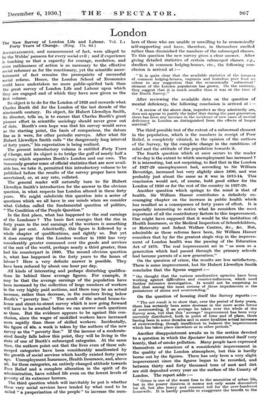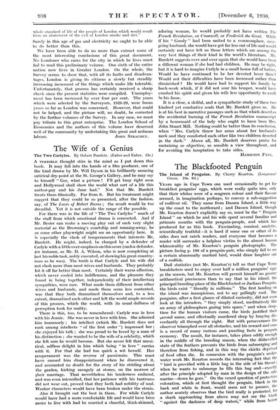London
AsCantetlinCENT, and measurement of fact, were alleged to be the Webbs' panacea for every social evil ; and if experience is teaching us that a capacity for courage, resolution, and even ruthlessness of action is as necessary to the effective social reformer as for the reactionary, yet the scientific ascer- tainment of fact remains the prerequisite of successful social reform. Hence, the London School of Economics could have undertaken no more public-spirited task than the great survey of London Life and Labour upon which they are engaged and of which they have now given us the first volume.
Its object is to do for the London of 1928 and onwards what. Charles Booth did for the London of the last decade of the nineteenth century. Its object, Sir Hubert Llewellyn Smith, its director, tells us, is to ensure that Charles Booth's great pioneer effort in scientific sociology should never grow out of date. Booth's own hope was that his survey would serve as the starting point, the basis of comparison, the datum line as it were, for other periodic surveys. After what Sir Hubert Llewellyn Smith calls " the dangerously long interval of forty years," his expectation is being realized.
The present introductory volume is entitled Forty Years of Change, and its object is to bridge the gulf of nearly half a century which separates Booth's London and our own. The immensely greater mass of official statistics that are now avail- able has, we take it, permitted this introductory volume to be published before the results of the survey proper have been ascertained, or, at any rate, collated.
The general reader will naturally turn to Sir Hubert Llewellyn Smith's introduction for the answer to the obvious question, in what respects has London altered in these forty years. We might subdivide this question into a series of questions which we all have in our minds when we consider what Cobden called the fundamental question of politics, " The Condition of the People Question."
In the first place, what has happened to the real earnings of the Londoner ? The basic fact emerges that the rise in forty years in the real earnings-of the workers is something like 80 per cent. Admittedly, this figure is followed by a whole chapter of qualifications, and rightly so. But yet it does emerge that the London worker in 1980 has very considerably greater command over the goods and services of the rest of the world, perhaps nearly a third greater, than had his counterpart in 1890. The second obvious question is, what has happened in the forty years to the hours of labour ? Here a very definite answer is possible. They have been reduced by about one hour per day.
All kinds of interesting and perhaps disturbing qualifica- tions lie behind these average figures. For example, it may be that the average earnings of the population have been increased by the collection of large numbers of workers in the very highly paid sections, and there may be an actual increase, rather than decrease, in the numbers living below Booth's " poverty line." The result of the actual house-to- house and street-to-street survey which is now going forward will have to be awaited before we can answer such questions as these. But the evidence appears to be against this con- clusion, since the wages of unskilled workers have increased more rapidly than those of skilled workers. Incidentally, the figure of 40s. a week is taken by the authors of the new survey as the " poverty line." If the income of a moderate- sized family falls below this point, they will be living in the state of one of Booth's submerged categories. At the same time, the authors point out that the lives even of these sub- merged categories have been considerably ameliorated by the growth of social services which hardly existed forty years ago. Unemployment Insurance, Health Insurrume, and, above all, for these categories, an entirely changed attitude towards Poor Relief and a complete alteration in the spirit of its administration, have robbed life even on the lowest levels of poverty of its extremer horrors.
The third question which will inevitably be put is whether these very social services have tended by what used to be called " a pauperization of the people" to increase the num- bers of those who are unable or unwilling to be economically self-supporting and have, therefore, in themselves swelled rather than diminished the numbers of the submerged classes. To this question the new survey gives a clear answer. After giving detailed statistics of certain submerged classes, e.g., dwellers in common lodging-houses, etc., the following con- clusion is arrived at :— " It is quite clear that the available statistics of the inmates of common lodging-houses, vagrants and homeless poor loud no colour to any suggestion that the economically subnormal • element of the London population has grown. On the contrary, they suggest that it is much smaller than it was at the time of the Booth Survey."
After reviewing the available data on the question of mental deficiency, the following conclusion is arrived at :—
"A review of the above data, imperfect as they admittedly are, does not appear to justify the belief that during the past generation there has been any increase in the incidence of new cases of mental deficiency in London as distinguished from the effects of longer survival."
The third possible test of the extent of a subnormal element in the population, which is the numbers in receipt of Poor Relief, is completely vitiated, in the opinion of the authors of the Survey, by the complete change in the conditions of relief and the attitude of the population towards it.
The fourth question which at once occurs to the reader of to-day is the extent to which unemployment has increased ? It is interesting, but not surprising, to find that in the London of 1927-29 unemployment had, according to Sir William Beveridge, increased but very slightly since 1890, and was probably just about the same as it was in 1013-14. This conclusion would not, of course, hold good either for the London of 1930 or for the rest of the country in 1927.29.
Another question which springs to the mind is that of health. Sir William Earner contributes a definitely en- couraging chapter on the increase in public health which has resulted as a consequence of forty years of effort It is especially interesting to notice what he considers the most important of all the contributory factors to this improvement. One might have supposed that it would be the institution of. Health Insurance, or the Medical Inspection of Schoolchildren, or Maternity and Infant Welfare Centres, &c., dic. But, admirable as these reforms have been, Sir William Earner considers that by far the greatest single step in the improve- ment of London health was the passing of the Education Act of 1870. The real improvement set in " as soon as a generation which had passed through the primary schools had become parents of a new generation."
On the question of crime, the results are less satisfactory. There is some improvement, but Sir Hubert Llewellyn Smith concludes that the figures suggest :—
" the thought that the various ameliorative agencies have been working against difficulties and counter•influences, which need further intensive investigation. It would not be surprising to find that among the most serious of these impediments is the persistence of alums and overcrowding."
On the question of housing itself the Survey reports :-
" The net result is to show that, ever the period of forty yearn, there has certainly been some decrease in the more acute forms of overcrowding, if an average be taken over the whole of the Survey area, but that this ' average' improvement has been very unevenly distributed, both in point of time and of place, there 'having been in some decades and in some localities actual increases of overcrowding, though insufficient to balance the improvement which has taken place elsewhere or in other periods."
Another disappointment awaits us in the section devoted to a question in which the Spectator has interested itself very keenly, that of smoke pollution. Many people have expressed themselves as conscious of a considerable improvement in the quality of the London atmosphere, but this is hardly borne out by the figures. There has only been a very slight improvement since the figures began to be recorded, and between thirty and forty thousand tons of soot and dirt are still deposited every year on the surface of the County of London. The report adds :- " Grime is one of the worst foes to the amenities of urban life, but in the poorer districts it means not only acute discomfort for all, but also heavy and constant toil for the over-burdened housewife. It is hardly possible to exaggerate the benefit to the
whole standard of life of the people of London which would result from an abatement of the evil of London smoke and dirt" Surely in this age of gas and electricity we ought to be able to do better than this.
We have been able to do no more than extract some of the most interesting conclusions of this great document. No Londoner who cares for the city in which he lives must fail to read this preliminary volume. One sixth of the entire nation now lives in Greater London. On the whole, the Survey seems' to show that, with all its faults and disadvan- tages, London is giving its citizens a slowly but steadily increasing increment of the things which make life tolerable. Unfortunately, that process has certainly received a sharp check since the present statistics were compiled. Unemploy- ment has been increased by over four per cent. The years which were selected by the Surveyors, 1928-29, were boom years so far as London was concerned. However, that could not be helped, and the picture will, no doubt, be corrected by the further volumes of the Survey. In any case, we must pay tribute to this great enterprise. The London School of Economics and the authors of this volume have deserved well of the community by undertaking this great and arduous



























































 Previous page
Previous page